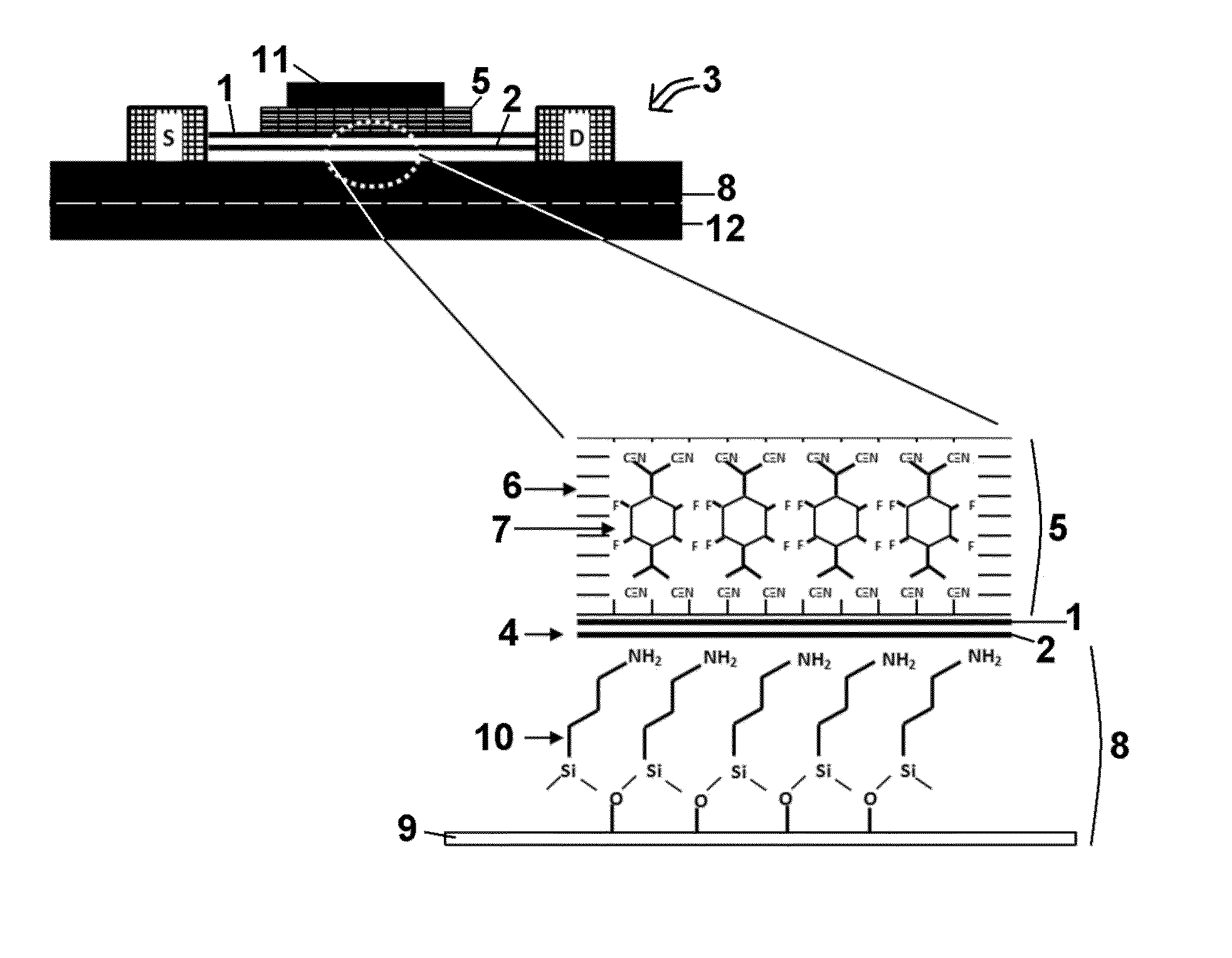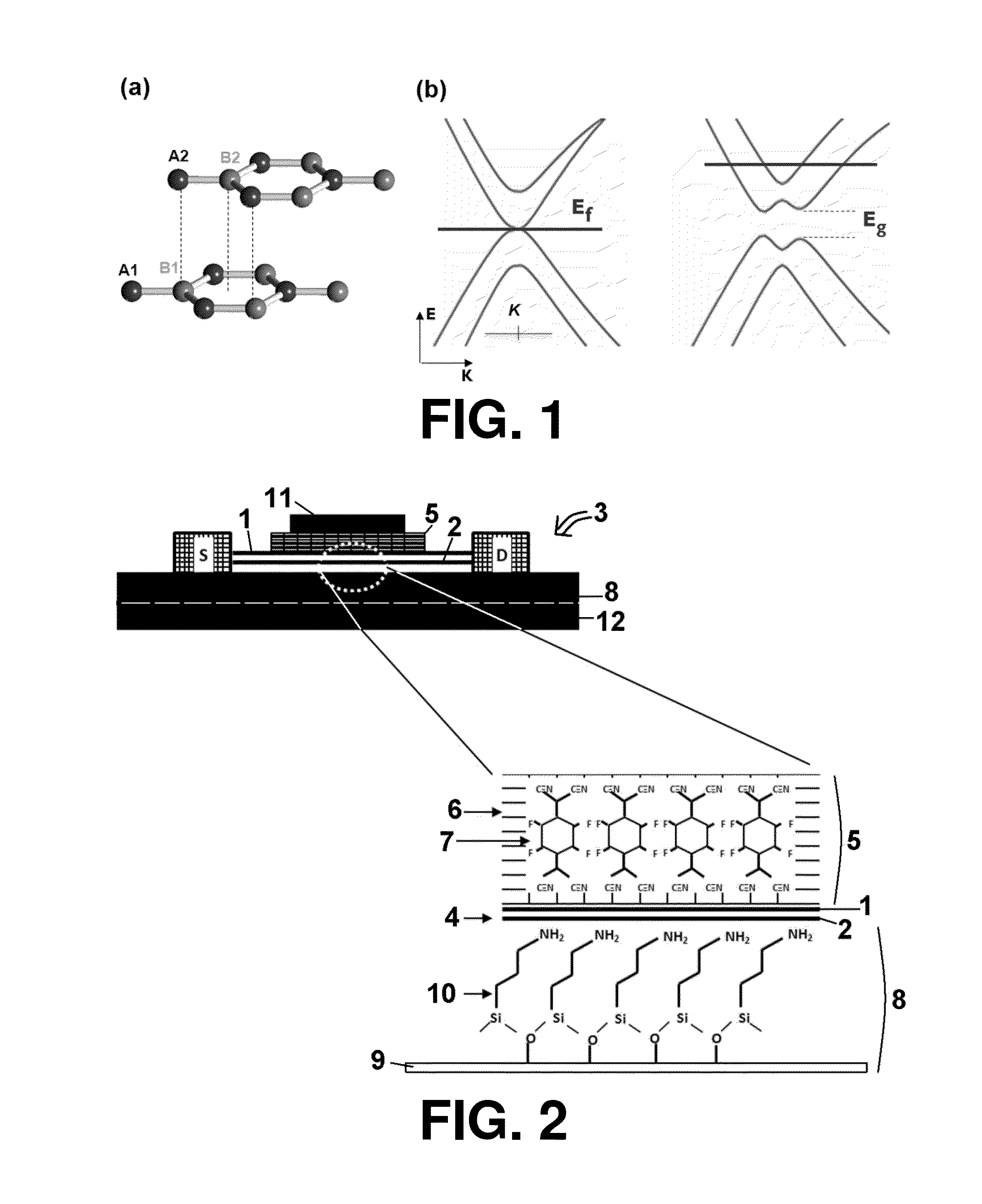Graphene-based semiconductor device
a graphene-based, semiconductor technology, applied in the direction of semiconductor devices, electrical appliances, nanotechnology, etc., can solve the problems of limiting factors affecting the use of graphene in logic applications, unable to switch off, and poor ion/ioff of transistors using slg as active channels,
- Summary
- Abstract
- Description
- Claims
- Application Information
AI Technical Summary
Benefits of technology
Problems solved by technology
Method used
Image
Examples
example 1
Preparation of a Field-Effect Transistor Using an Electrically Insulating Layer Comprising Polystyrene and a p-Dopant
Substrate Preparation:
[0075]Substrates consisting of Si wafers (12, see FIG. 2) with 300 nm thermally grown Si oxide were cleaned for 10 min in a 1:1:5 NH4OH:H2O2:H2O solution (75° C.) to remove contaminants.
[0076]Substrate silanization was then carried out by vertically dipping the substrate in a 0.5% vol. 3-aminopropyl triethoxysilane solution (APTES) in anhydrous toluene for 1 h, rinsing well with toluene and sonicating in isopropanol to remove noncovalently bonded silane molecules. A self assembled monolayer (SAM, 10 see FIG. 2) was thereby obtained.
[0077]The sample was then further annealed under N2 atmosphere at 120° C. to improve the quality of SAM.
Graphene Deposition:
[0078]Samples bearing a single layer graphene and samples bearing a bilayer graphene were prepared. For this purpose, SLG and BLG were respectively deposited on silanized substrates by micromechan...
example 2
Coupling of a Top Gate Electrode to the Electrically Insulating Layer Comprising Polystyrene and a p-Dopant
[0109]A top gate electrode is defined on the electrically insulating layer by optical lithography.
[0110]This has the advantage over Example 1 to permit an increase of the magnitude of the induced electrical field. Thereby, the device benefits from both external and molecular gates.
example 3
Preparation of a Field-Effect Transistor (3) Using an Electrically Insulating Layer (5) Comprising a High-k Polymer (6) and a p-Dopant (7), Said Insulating Layer (5) being Coupled to a Top Gate Electrode (11)
[0111]Referring to FIG. 2, for the preparation of a field-effect transistor (3) using an electrically insulating layer (5), the same procedure as described in Example 1 is repeated except that in the preparation of the polymer (6) / F4TCNQ (7) blends (5), a high-k polymer (6) (having a relative permittivity of at least 4.0) is used instead of polystyrene. Typically, Poly(trifluoroethylene) or poly(vinylidene fluoride) is used.
[0112]Similarly to Example 1, high-k polymer (6) / F4TCNQ (7) blends (5) with different concentrations are prepared and the dielectric constant and break-down voltage of each blend (5) is measured in order to find the optimum concentration of F4TCNQ (7).
[0113]For the Coupling of a top gate electrode (11) to the high-k electrically insulating layer (5), the same...
PUM
 Login to View More
Login to View More Abstract
Description
Claims
Application Information
 Login to View More
Login to View More - R&D
- Intellectual Property
- Life Sciences
- Materials
- Tech Scout
- Unparalleled Data Quality
- Higher Quality Content
- 60% Fewer Hallucinations
Browse by: Latest US Patents, China's latest patents, Technical Efficacy Thesaurus, Application Domain, Technology Topic, Popular Technical Reports.
© 2025 PatSnap. All rights reserved.Legal|Privacy policy|Modern Slavery Act Transparency Statement|Sitemap|About US| Contact US: help@patsnap.com



